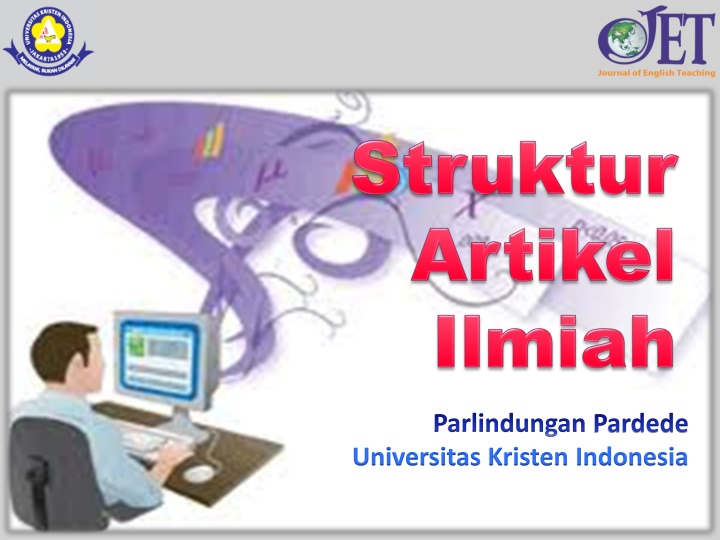
Characteristics of Academic Articles: Understanding and Writing Guidelines
Learn about the importance and structure of academic articles, differentiate between academic and fictional articles, and discover why writing academic articles is essential for ELT research and scholarly communication. Dive into the world of scholarly writing with insights on writing methods, logical frameworks, and standard practices within academic articles.
Download Presentation

Please find below an Image/Link to download the presentation.
The content on the website is provided AS IS for your information and personal use only. It may not be sold, licensed, or shared on other websites without obtaining consent from the author. If you encounter any issues during the download, it is possible that the publisher has removed the file from their server.
You are allowed to download the files provided on this website for personal or commercial use, subject to the condition that they are used lawfully. All files are the property of their respective owners.
The content on the website is provided AS IS for your information and personal use only. It may not be sold, licensed, or shared on other websites without obtaining consent from the author.
E N D
Presentation Transcript
Parlindungan Pardede Universitas Kristen Indonesia
Visi Visi & & Misi Misi PBI UKI PBI UKI Misi Visi Menyelenggarakan pembelajaran Bahasa Inggris yang kreatif dengan menerapkan teknologi informasi dan komunikasi. Meningkatkan kuantitas dan kualitas penelitian dalam bidang Pendidikan Bahasa Inggris yang dipublikasikan di tingkat nasional dan internasional menyelenggarakan kegiatan ilmiah di bidang Pendidikan Bahasa Inggris yang berkualitas di tingkat nasional dan internasional. Meningkatkan kuantitas dan kualitas pengabdian kepada masyarakat dalam bidang Pendidikan Bahasa Inggris yang berkelanjutan dan dipublikasikan Meningkatkan kerjasama dengan institusi nasional maupun internasional dalam bidang Tridarma Perguruan Tinggi Menjadi Program Studi Pendidikan Bahasa Inggris unggulan melalui Tridarma Perguruan Tinggiberdasarkan Pancasila, nilai-nilai kristiani, dan penerapan teknologi informasi dan komunikasi di Jabodetabek pada tahun 2025
Perngertian Artikel Ilmiah Tulisan non-fiksi yang membahas sebuah subjek dan dirancang untuk dipublikasikan di media masa atau jurnal, atau untuk dipresentasikan di seminar/konferensi.
Mana yang (bukan) artikel? Doub thou the stars are fire, Doub thou the sun doth move, Doubt truth to be a liar, But never doubt my love. Shakespeare
ARTIKEL ILMIAH FIKSI Mengkomunikasikan metode & hasil penelitian Ditulis dengan kerangka yang teratur, logis, dan standar Menggunakan kalimat yang singkat, gramatikal, dan logis. Mengkomunikasikan perasaan, pengalaman, dan ide. Ditulis dengan format dan gaya personal Menggunakan kalimat yang berbunga-bunga dan personal.
Mengapa Artikel Ilmiah Perlu ditulis? ELT Research ELT ELT Research Research ELT ELT Research Research ELT Research
Struktur Artikel Ilmiah= format yang diterima secara luas untuk menyajikan isi sebuah artikel ilmiah. Struktur Artikel Ilmiah harus ditulis dalam format yang diterima secara luas untuk menjamin bahwa masalah penelitian, landasan teori, metode penelitian, hasil, analisis, dan implikasi tulisan tersebut dapat diidentifikasi dengan mudah oleh pembaca
Generic Structure of Scientific Articles bstract ntroduction ethodology (Method & Material) sults iscussions onclusion nd eferences
Varieties of Scientific Articles Structure AIM(RaD)C AIMReDCaR AIMRaD AIRDaM Abstract Introduction Method Result 1 Discussion 1 Result 2 Discussion 2 Conclusions Abstract Introduction Method Results Discussion Conclusion References Abstract Introduction Method Results Discussions Abstract Introduction Results Discussions Methods
AIMRAD Format (a) Results governs the whole structure; all things in the article must relate to the data and analysis presented in the Results section. (b)(1) The Introduction begins with a broad focus but attracts the lively interest of the readers of the target journal. (3) The Introduction ends with a focus exactly parallel to that of the Results; it is a statement of the aim of the work presented in the paper, or its principal findings or activity. (2) Between these two points, background information and previous relevant works are woven together (c) The Methods section establishes credibility for the Results by showing how they were obtained. (d) The Discussion begins with the same breadth of focus as the Results. By the end, the paper show conclusions and suggestions
AIRDaM Format (a) The Methods section, often renamed Procedure or Experimental, is presented after the Discussion, sometimes in a smaller type face than the rest of the paper. (b) This change means that more details may need to be given in the Results section to explain how the results were obtained
AIM(RaD)aC Format (a) The Results and Discussion are presented together in a single combined section; each result is presented, followed immediately by the relevant discussion. (b) This change means that a separate section is needed at the end to bring the different pieces of discussion together; it is often headed Conclusions.
Generic Structure of Scientific Articles bstract ntroduction ethodology (Method & Material) sults iscussions onclusion nd eferences
Abstract Section Summarizes the major aspects of a paper. limited by most journals to 150 to 250 words or even less a minipaper covering: (1) Objective; (2) Materials and Methods; (3) Results; (4) Conclusions. Ended with a list of three to five key words or short phrases for indexing
Introduction Section (1) Presents background information a reader needs to understand the rest of the paper Written like a continuous essay, but in some others it is broken down into different components (subheadings) 300 to 500 words in length, but may be more, depending on the journal and the topic
Introduction Section (2) General format: (1) Problem and its background in a broad scope (1 paragraph); (2) Specific problem to be studied, reasons of importance to study, and how it applied to the larger field of research (in 2 or 3 paragraphs); (3) Clear statement of hypothesis (for experimental study) and objectives of the paper; (4) a brief summary of previous relevant studies by other researchers in the field to bring the reader up to date on the topic written in some paragraphs; (5) explanation of concepts or definitions of operational terms used (1 paragraph). In some journals, the previous relevant studies summary (no. 4 above) is put in a specific section separated from the introduction, and is called called Literary Review.
Methodology (Methods & Materials) Section Describes the research procedures and highly necessary for readers who want to repeatthe study Includes: (1) Subjects (humans, animals, plants) and their pre- experiment handling and care (2) Sample preparation techniques; (3) Origins of samples and materials; (4) Description of the field site, including physical and biological features, and exact location (include a map, if applicable); (5) Procedures for collecting data; (6) Statistical analysis techniques (7) Information on computer programs used (8) Descriptions of equipment set-up and function.
Results Section General statements presenting the key results (data) of the research without interpreting their meaning. The presented data are not the raw ones, but have been transformed into text, illustrations, charts, and tables. Includes the statements of statistical analyses
Discussion Section Takes and interprets the findings reported in the Results section by evaluating their significance, and examining the implications. Template: Paragraph 1: What did this study show? Address the aims stated in the Introduction Paragraph 2: Strengths and weaknesses of methods Paragraphs 3 to n 1: Discuss how the results support the current literature or refute current knowledge Final paragraph: Future directions ( So what? and where next? Impact on current thinking or practice)
Conclusion Section Presents: (1) a succinct summary of implications of the findings; (2) general implications of the study; (3) suggestions for further research.
References Section Used (1) to give credit to the cited ideas and works of other scientists; and (2) to provide the readers with access to these sources. Some journals uses the American Psychological Association (APA) style; others, (Modern Language Association (MLA) style; and some others created their own style. List cited sources only; this is not a Bibliography !
REFERENCES Brandt, C. (2010). Competition and collaboration in initial teacher education in TESOL: A Case of a Classic Double Bind. Asian EFL Journal. 12(3),8-39. Cargill, M. and O Connor, P. (2009). Writing scientific research articles: Strategy and steps. Chichester, West Sussex: John Wiley & Sons Ltd. Journal of Young Investigators. (2005). Writing scientific manuscripts: A guide for undergraduates. Retrieved on October 21, 2010 from: www.jyi.org Katz, M. J. (2009). From research to manuscript: A guide to scientific writing. Cleveland: Springer. Language Learning & Technology. (2010). LLT research guidelines for quantitative and qualitative research. Retrieved on April 24, 2010 from: http://llt.msu.edu/resguide.html Lebrun, J. (2007). Scientific writing: A reader and writer s guide. Singapore: World Scientific Publishing Co. Pte. Ltd. Nazara, S. (2011). Students perception on EFL speaking skill development. Journal of English Teaching. 1(1), 29-44. Peat, J. (2002). Scientific writing: Easy when you know how. London: BMJ Books. Shang, H. (2010). Reading strategy use, self-efficacy and EFL reading comprehension. Asian EFL Journal. 12(2),18-42. Yang, J. (1999). An outline of scientific writing: for researchers with English as a foreign language. Singapore: World Scientific Publishing Co. Pte. Ltd.


